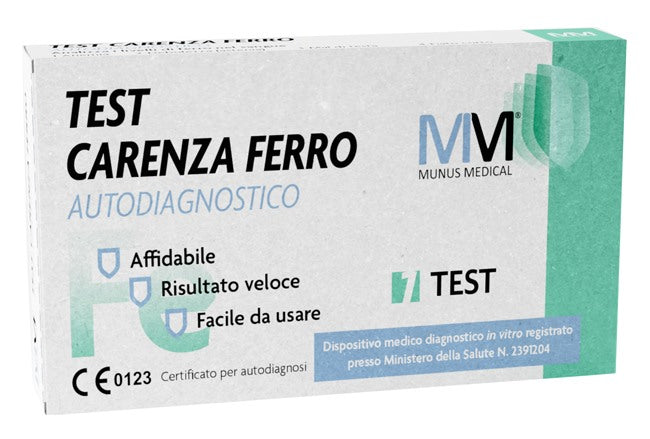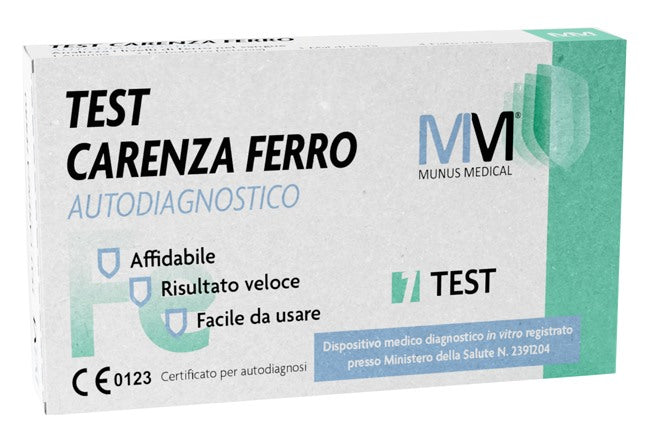MUNUS MEDICAL SELF-DIAGNOSTIC TEST IRON DEFICIENCY MUNUS
Sold out
€9,90
Unit price
/
Unavailable
Tax included, shipping and discounts calculated at checkout.
Munus | SKU:
986885109
Notify me when it's back in stock!
Write us your email, you will be notified when this product becomes available again!
MUNUS MEDICAL SELF-DIAGNOSTIC TEST IRON DEFICIENCY MUNUS is backordered and will ship as soon as it is back in stock.
Shipping Costs and Times
Shipping Costs and Times
- Order fulfillment within 24 hours and delivery within the following 48/72 hours.
- Shipping cost: always free for orders over €49.90, otherwise it costs €4.99.
Payments
Payments
Payment information is processed securely. We do not store credit card information or have access to your credit card information.
Returns and Refunds
Returns and Refunds
You can return and receive a refund for the item within 30 days. See full policy here.

Do you need help?
Our customer service is here to help you!
- Contact us by phone, email or WhatsApp, from Monday to Friday, from 9:00 to 20:00 .
- For common questions, such as tracking your order or checking its fulfillment status, you can count on our artificial intelligence , available 24/7 .
We are always at your side to offer you fast and effective support!
Description
Description
MUNUS MEDICAL SELF-DIAGNOSTIC TEST IRON DEFICIENCY MUNUS
MUNUS MEDICAL
IRON DEFICIENCY TEST
Description
Rapid test for the qualitative determination of ferritin in human blood from fingerstick for iron deficiency anemia.
The membrane is coated with a polyclonal anti-ferritin antibody on the test line area. The gold particle is coated with a monoclonal anti-ferritin antibody and rabbit IgG.
During the test, the sample reacts with the particle coated with monoclonal anti-ferritin antibodies. The mixture then migrates chromatographically up the membrane by capillary action and reacts with the polyclonal anti-ferritin antibody present on the membrane, generating a colored line. If the ferritin level exceeds the cut-off level of 30 ng/mL, the line appears in the test region (T). If the ferritin concentration is less than 30 ng/mL, the test line does not appear.
For procedural control purposes, a colored line will always form in the control region to indicate that an adequate volume of sample has been added and capillary penetration into the membrane has occurred.
How to use
Bring the case to room temperature before opening. Open the case and remove the cassette.
Wash your hands with soap and rinse with warm water.
Carefully remove the lancet cap and discard. Use the alcohol swab to clean the tip of your middle or ring finger as the puncture site. Press the lancet from the side where the cap was removed against your fingertip (it is best to do this on the ring finger). The tip automatically and safely retracts after use. With your hand down, massage the pricked tip to release a drop of blood.
Without squeezing the bulb of the capillary dropper, bring it into contact with the blood. The blood will migrate into the capillary dropper to the line indicated on the dropper. You can massage your finger to get more blood if the line is not reached. Avoid air bubbles as much as possible.
Place the collected blood into the sample well of the cassette by pressing the dropper bulb. Wait until the blood is completely transferred to the well. Unscrew the cap of the buffer bottle and add 1 drop of buffer to the sample well on the cassette.
Wait for the colored line(s) to appear. Read the results after 5 minutes. Do not interpret the results after 10 minutes.
Reading the results
Normal: Two colored lines appear. Both the T (test) and C (control) lines appear. This result means that the ferritin concentration in the blood is normal and that there is no potential iron deficiency.
Abnormal: Only one colored line appears, the control line (C). This result means that the concentration of ferritin in the blood is too low. You should consult a doctor because you may have an iron deficiency.
Invalid: No control line appears. Insufficient sample volume or incorrect procedural techniques are the most likely causes for a missing control line.
Review the procedure and repeat the test with a new test. If the problem persists, stop using the test kit immediately and contact your local distributor.
Warnings
Please read all the information in this leaflet carefully before performing the test.
For in vitro diagnostic self-testing only.
Do not eat, drink, or smoke in the area where specimens or kits are being handled.
This kit is intended for use as a preliminary test only and repeatedly abnormal results should be discussed with a physician or healthcare professional.
Strictly follow the indicated timings.
Use the test only once. Do not disassemble or touch the test window of the test cassette.
The kit must not be frozen or used after the expiration date printed on the package.
Keep out of reach of children.
The used test must be disposed of according to local regulations.
The test provides only a qualitative analytical result. A second analytical method must be used to confirm the result.
Technical or procedural errors, as well as interfering substances in the whole blood sample, may cause erroneous results.
As with all diagnostic tests, all results should be considered in conjunction with other clinical information available to the physician.
If the results obtained are questionable, further clinical tests are necessary.
Conservation
Store in the package at room temperature or refrigerated (2-30 °C). Do not freeze.
The test is stable until the expiration date.
The test must remain in the sealed pouch until use. Do not use after the expiration date.
Validity with intact packaging: 24 months.
Format
The kit contains:
- test cassette;
- capillary dropper;
- buffer;
- alcohol swab;
- hand;
- package leaflet.
Bibliography
1. Kryger MH, Otake K, Foerster J (March 2002). “Low body iron stores and restless legs syndrome: a correctable cause of insomnia in adolescents and young adults.” SleepMed.3(2): 127-32.
2. Mizuno S, Mihara T, Miyaoka T, Inagaki T, Horiguchi J (March 14, 2005). “Cerebrospinal fluid iron, ferritin, and transferrin levels in restless legs syndrome.” J Sleep Res1: 43-7.
Cod. MM-OFE-402H
Rapid test for the qualitative determination of ferritin in human blood from fingerstick for iron deficiency anemia.
The membrane is coated with a polyclonal anti-ferritin antibody on the test line area. The gold particle is coated with a monoclonal anti-ferritin antibody and rabbit IgG.
During the test, the sample reacts with the particle coated with monoclonal anti-ferritin antibodies. The mixture then migrates chromatographically up the membrane by capillary action and reacts with the polyclonal anti-ferritin antibody present on the membrane, generating a colored line. If the ferritin level exceeds the cut-off level of 30 ng/mL, the line appears in the test region (T). If the ferritin concentration is less than 30 ng/mL, the test line does not appear.
For procedural control purposes, a colored line will always form in the control region to indicate that an adequate volume of sample has been added and capillary penetration into the membrane has occurred.
How to use
Bring the case to room temperature before opening. Open the case and remove the cassette.
Wash your hands with soap and rinse with warm water.
Carefully remove the lancet cap and discard. Use the alcohol swab to clean the tip of your middle or ring finger as the puncture site. Press the lancet from the side where the cap was removed against your fingertip (it is best to do this on the ring finger). The tip automatically and safely retracts after use. With your hand down, massage the pricked tip to release a drop of blood.
Without squeezing the bulb of the capillary dropper, bring it into contact with the blood. The blood will migrate into the capillary dropper to the line indicated on the dropper. You can massage your finger to get more blood if the line is not reached. Avoid air bubbles as much as possible.
Place the collected blood into the sample well of the cassette by pressing the dropper bulb. Wait until the blood is completely transferred to the well. Unscrew the cap of the buffer bottle and add 1 drop of buffer to the sample well on the cassette.
Wait for the colored line(s) to appear. Read the results after 5 minutes. Do not interpret the results after 10 minutes.
Reading the results
Normal: Two colored lines appear. Both the T (test) and C (control) lines appear. This result means that the ferritin concentration in the blood is normal and that there is no potential iron deficiency.
Abnormal: Only one colored line appears, the control line (C). This result means that the concentration of ferritin in the blood is too low. You should consult a doctor because you may have an iron deficiency.
Invalid: No control line appears. Insufficient sample volume or incorrect procedural techniques are the most likely causes for a missing control line.
Review the procedure and repeat the test with a new test. If the problem persists, stop using the test kit immediately and contact your local distributor.
Warnings
Please read all the information in this leaflet carefully before performing the test.
For in vitro diagnostic self-testing only.
Do not eat, drink, or smoke in the area where specimens or kits are being handled.
This kit is intended for use as a preliminary test only and repeatedly abnormal results should be discussed with a physician or healthcare professional.
Strictly follow the indicated timings.
Use the test only once. Do not disassemble or touch the test window of the test cassette.
The kit must not be frozen or used after the expiration date printed on the package.
Keep out of reach of children.
The used test must be disposed of according to local regulations.
The test provides only a qualitative analytical result. A second analytical method must be used to confirm the result.
Technical or procedural errors, as well as interfering substances in the whole blood sample, may cause erroneous results.
As with all diagnostic tests, all results should be considered in conjunction with other clinical information available to the physician.
If the results obtained are questionable, further clinical tests are necessary.
Conservation
Store in the package at room temperature or refrigerated (2-30 °C). Do not freeze.
The test is stable until the expiration date.
The test must remain in the sealed pouch until use. Do not use after the expiration date.
Validity with intact packaging: 24 months.
Format
The kit contains:
- test cassette;
- capillary dropper;
- buffer;
- alcohol swab;
- hand;
- package leaflet.
Bibliography
1. Kryger MH, Otake K, Foerster J (March 2002). “Low body iron stores and restless legs syndrome: a correctable cause of insomnia in adolescents and young adults.” SleepMed.3(2): 127-32.
2. Mizuno S, Mihara T, Miyaoka T, Inagaki T, Horiguchi J (March 14, 2005). “Cerebrospinal fluid iron, ferritin, and transferrin levels in restless legs syndrome.” J Sleep Res1: 43-7.
Cod. MM-OFE-402H


